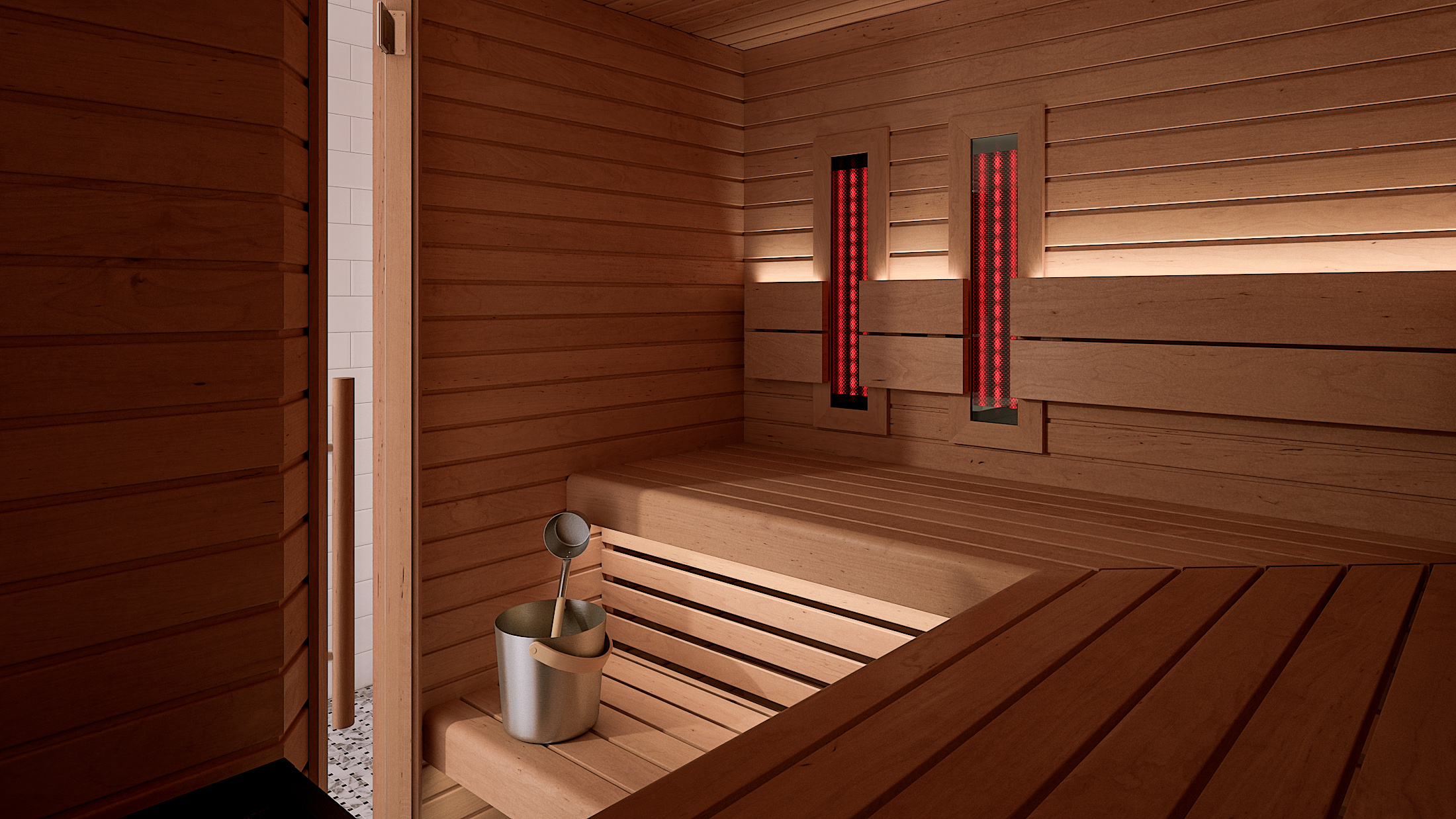
Key Takeaways -
- A sauna is a steam bath used primarily for relaxation and health benefits, such as improved circulation and muscle relaxation.
- The ideal temperature for a sauna should be between 75 - 85 degrees Celsius (170-185 Fahrenheit).
- The humidity should also be kept at a comfortable level, around 40 – 60%. This helps the body sweat better and enables easier breathing.
Step into the comforting world of saunas! Whether you're aware or not, these havens are a brilliant way to take a load off. Did you know that there is an optimal temperature for your preferred sauna experience?

For an optimum sauna experience, the suggested temperature range falls between 158°F (70°C) and 212°F (100°C). Beginners should begin with a lower setting, while seasoned visitors may opt for higher temperatures.
This article will explain why setting an optimal temperature range is essential to ensuring your comfort and enjoyment. We'll consider the factors that affect this ideal temperature, as well as how much heat or cold it's acceptable to tolerate. So let's begin.

Types of Saunas and Recommended Temperatures
Each type of sauna has its own temperature range that is SUITABLE for the experience. Let's look at the most popular types of saunas and the recommended temperature range for each one.

Traditional Saunas
Traditional saunas are the most COMMON type of sauna, using dry heat from heated rocks to warm the air.
The recommended temperature for a traditional sauna is between 176°F and 212°F (80°C - 100°C). It's important to remember that HIGHER temperatures don't necessarily mean better results - heating the air too much can lead to uncomfortable and dangerous conditions.

Infrared Saunas
Infrared saunas use far infrared light to heat the body DIRECTLY rather than heating the air. The recommended temperature for an infrared sauna is typically lower than a traditional sauna, usually between 110°F and 140°F (43°C - 60°C).
Infrared saunas are often said to be more COMFORTABLE because they don't heat up as quickly or as high as traditional saunas.

Steam Saunas
Steam saunas heat the air, creating a more HUMID atmosphere than traditional or infrared saunas. The recommended temperature for a steam sauna is between 110°F and 120°F (43°C - 49°C).
Effects of Temperature on the Body in a Sauna
The temperature of a sauna can have significant effects on the body, both positive and negative. At lower temperatures (below 158°F/70°C), the body won't be able to SWEAT effectively or benefit from the detoxifying properties of a sauna.
At higher temperatures (above 212°F/100°C), the heat can become uncomfortable and even DANGEROUS for some people, leading to dehydration or heat exhaustion.
Let's take a closer look at how different temperatures AFFECT the body and what to consider when setting the perfect sauna temperature.

Increased Heart Rate & Blood Pressure
When exposed to high infrared sauna temperature, the body's NATURAL response is to increase heart rate and blood pressure. This is due to the body's attempt to cool itself down and regulate its core temperature.
Studies have shown that this increase in heart rate and blood pressure can be comparable to that seen with low-to-moderate intensity physical exercise [1].

Sweating & Detoxification
Sweating is an important part of sauna use as it helps rid the body of TOXINS. The high temperatures cause sweat glands to open up, allowing for more sweat production and detoxification.
Pro Tip: Sweat also helps cool the body and regulate its core body temperature [2].

Relaxation & Stress Relief
The combination of heat and humidity in a sauna can provide a sense of relaxation and stress relief. The heat helps RELAX muscles, while the humidity helps reduce tension in the airways, allowing for easier breathing.
Additionally, studies have found that regular sauna use may IMPROVE cardiovascular function by improving endothelium-dependent dilatation, reducing arterial stiffness, and increasing cardiac output [3].
Potential Risks & Precautions for Hotter Temperatures
When using a sauna, it's important to remember that higher temperatures can become DANGEROUS. Let's take a look at some of the potential risks associated with higher temperatures, as well as precautions to take when using a sauna.

Overheating & Fainting
Saunas are meant to provide a pleasant RELAXING experience, but if the temperature is too high, it can lead to uncomfortable and even dangerous conditions.
Overheating can cause lightheadedness and FAINTING, so if you feel any of these symptoms, it's important to leave the sauna immediately.

Excessive Sweating
When a steam sauna temperature gets too hot or users stay in the sauna too long, EXCESSIVE sweating can occur. Excessive sweating not only causes discomfort but also leads to dehydration which can have serious consequences on physical health.
Pro Tip: Make sure to replenish fluids before, during, and after a steam room (sauna) session.

Dehydration
As mentioned above, excessive sweating in a sauna can lead to DEHYDRATION which can lead to headaches, dizziness, confusion and fatigue. It's important to drink plenty of fluids before and after your sauna session in order to reduce the risks of dehydration and overheating.

Medical Conditions
If you have any medical conditions, it's important to consult with your doctor before using steam rooms and saunas. Certain medical conditions or MEDICATIONS can make it dangerous to use a sauna at higher temperatures.
Such as heart problems, high blood pressure, pregnant women, and more. Your doctor can help you determine what the best temperature is for your sauna session and ADVISE of any precautions.

Age
Sauna use with family and friends should also be LIMITED to those that meet the age requirement (usually over 18 years old).
It's important to be aware that higher temperatures are not suitable for YOUNGER users, as they may be more susceptible to dehydration and heat exhaustion.
Pro Tip: Always check with your doctor if you're unsure about the potential risks of using a sauna.
Frequently Asked Questions
How Do I Safely Increase The Heat In A Sauna Over Time To Acclimate My Body?
When starting out, it's best to begin with, shorter sauna sessions at lower temperatures and then gradually increase the temperature over time to allow your body to acclimate.
How Do I Know If A Sauna Session Is Too Hot For Me?
If you feel lightheaded, dizzy or overheated, it's important to leave the sauna immediately. Additionally, if your skin becomes red and starts to hurt, it may be an indication that the temperature is too high.
What Sauna Temperature Is Dangerous?
At higher temperatures (above 212°F/100°C), the heat can become uncomfortable and even dangerous for some people, leading to dehydration or heat exhaustion.

Conclusion
So what is the ideal sauna temperature? Ultimately, the perfect sauna temperature will depend on personal preference and can be determined by gradually increasing the heat over time.
However, it's important to keep in mind that temperatures above 212°F/100°C can become dangerous, leading to dehydration or heat exhaustion.
Make sure to listen to your body before, during, and after a sauna session, and take breaks if you feel lightheaded or dizzy.
Done correctly and with precaution, saunas can be a great way to relax and detoxify the body.
Source -
- Nystoriak MA, Bhatnagar A. Cardiovascular Effects and Benefits of Exercise. Frontiers in Cardiovascular Medicine. 2018;5. doi:https://doi.org/10.3389/fcvm.2018.00135
- How Sweat Works: Why We Sweat When We’re Hot, as Well as When We’re Not. Houstonmethodist.org. Published 2020. Accessed February 6, 2023. https://www.houstonmethodist.org/blog/articles/2020/aug/how-sweat-works-why-we-sweat-when-we-are-hot-as-well-as-when-we-are-not/#
- Laukkanen JA, Laukkanen T, Kunutsor SK. Cardiovascular and Other Health Benefits of Sauna Bathing: A Review of the Evidence. Mayo Clinic Proceedings. 2018;93(8):1111-1121. doi:https://doi.org/10.1016/j.mayocp.2018.04.008
Content editor, marketer and product tester. A regular contributor for the ‘Home And Garden’ and Modern Homes Magazines, now part of a close-knit team, I oversee all the content on Posh. All roads have led to this job which I love. I get to focus on my love of interior design and health and work with a fabulous team. The role brings me a good level of freedom to my family and me and keeps me productive











